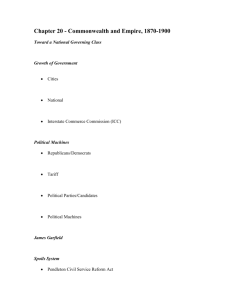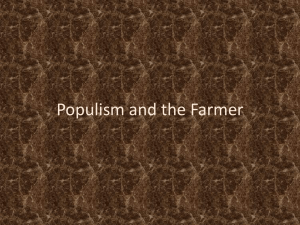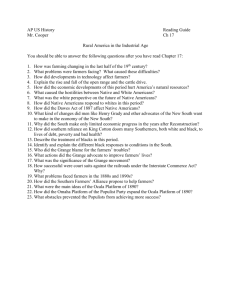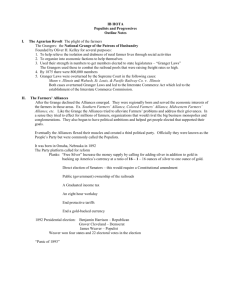Wabash v. Illinois
advertisement
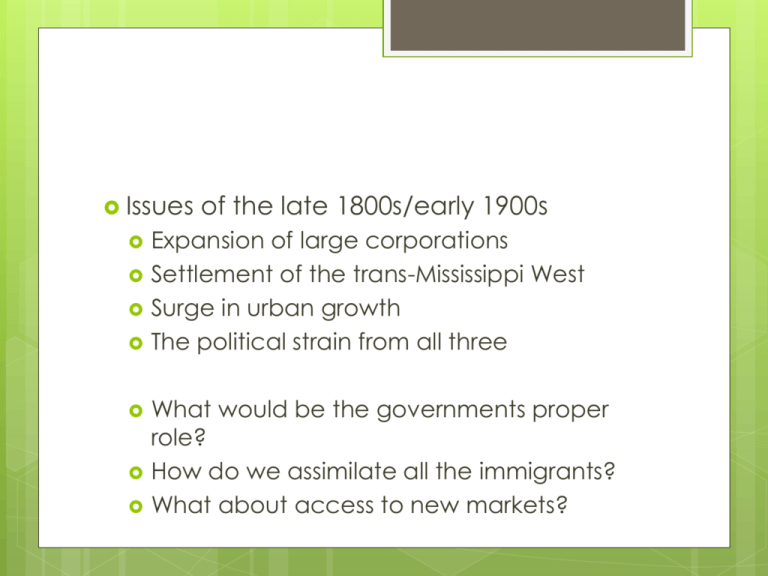
Issues of the late 1800s/early 1900s Expansion of large corporations Settlement of the trans-Mississippi West Surge in urban growth The political strain from all three What would be the governments proper role? How do we assimilate all the immigrants? What about access to new markets? From 1877 to 1884 political struggles were intense: Pres. Elections were close; House changed five times; seven new states admitted Democrats control the South Republicans consolidate their coalition in 1896 Elections during this time had high voter turnout (80%) Navigating unsure economic times Influx of immigrants Growth of cities However, DC ignored most problems generated by industrialization Contested political visions Republicans became the party supporting expansion of the railroad, tariff protection, land subsidies for farmers, preserver of the family Democrats viewed emancipation as a threat to patriarchy Neither party thought the govt. should regulate corporations or protect the social welfare of workers Laissez-faire was the rule People looked more towards local authorities Women were pulled into politics because both parties linked economic prosperity to family values Patterns of Party Strength Republicans and Democrats then are not the same as today In the late 1800s Republicans ruled rural and small town New England, PA, and upper Midwest; they ran military leaders and “waved the bloody shirt” Democrats ruled the South and northern cities; southerners campaigned for minimal govt., opposed tariff increases, and attacked govt. interference in the economy Especially in the North they opposed prohibition and English language requirements The role of governmental authority shaped the general political debate, but family tradition, ethnic ties, religious affiliation, and local issues determined an individual’s vote Catholics (esp. Irish) and Germans voted Dem. Old-stock northerners (75% of Methodists and Congregationalists; 65% of Baptists; 60% of Presbyterians) voted Rep. British-born Protestants and 80% of Swedish and Norwegian Lutherans voted Rep. African Am. Voted Rep. Social issues were key: prohibition, prostitution, gambling, Sabbath observance Regulating Money Supply How to create a money supply adequate for a growing economy without producing inflation Americans revered gold and silver Bankers, creditors, business leaders, politicians, economists favored sound money Southerners and westerners favored expanded money The first question was Greenbacks Greenback Party forms in 1877 and wins congressional seats The next question was silver Sherman Silver Purchase Act of 1890: the Treasury was to purchase 4.5 million ounces of silver monthly The Spoils System The push for civil service reform Hayes launches an investigation of New York City customs offices: Future president Arthur is one of the spoils issuers Garfield wins the election of 1880 Garfield is assassinated by a begrudged civil service workers that expected patronage Arthur, the poster child for corruption, takes over For the fallen president, the Pendleton Civil Service Act is passed Competitive exams; standards of merit; political candidates can’t solicit from government workers (initially only 12%) 1884: Cleveland Victories Republicans nominate a young James Blaine Democrats nominate Grover Cleveland (many Republicans bolted to him – Mugwumps) Supposed to be different from Grantism However had fathered an illegitimate child; “Ma, Ma, where’s my pa?” Cleveland was also opposed by Tammany Hall Democrats were denounced as the party of “Rum, Romanism, and Rebellion” Tariffs and Pensions Tariff issue Which products, commodities, or raw materials? the high tariffs of the 1880s had created a budget surplus; was this bad? Cleveland found it a corrupting influence because of pork-barrel projects (a paternalistic govt.) Pension issue Cleveland also took on the GAR (Grand Army of the Republic) over costly pensions He vetoed a bill which would have pensioned all disabled veterans 1888: Big Business and the GAR strike back Nominating Benjamin Harrison (weak) Hit the tariff issue, focusing on the importance of having a high protective tariff Ensured prosperity, Provided decent wages, and a Healthy home market for farmers They got around the Pendleton Civil Service Act and received money from corporations ($4 million) Cleveland won the popular; Harrison won the College Pension rolls ballooned from 676,000 to about 1,000,000 (America’s first public welfare program) 1890 the Rep. passed the McKinley Tariff The Grange Abundant harvests undercut prices Beginning in 1867 farmers begin to form cooperatives Oliver Kelley and the Grange (Patrons of Husbandry) Offered information, emotional support, and fellowship By less and produce more Set up cash-only cooperatives The also attacked the railroads, who always charged less for large producers and bribed legislators The lobbied state legislatures Munn v. Illinois (1877) – court upheld the law to set a maximum rate, however. . . Wabash v. Illinois (1886) – court held that states can’t regulate interstate railroad rates Congress passes the Interstate Commerce Act of 1887 – federal authority; est. the ICC (all it did was est. the feds role) The railroads may have lost at the national level, but the won at the state’s by lobbying state govts. Most state repealed regulation laws by 1878 The Grange ultimately collapses under the weight of the “necessity” – borrowing money After the crop was grown all else was out of the farmers control: Farmers were at the mercy of local merchants and farm equipment dealers, railroads form transportation Alliance Movement Centered in the South and West (Grange was the Plains) Begin in Texas in the 1870s but became the National Farmers’ Alliance and Industrial Union (or Southern Alliance); a parallel black org., the National Colored Farmers’ Alliance emerge in Arkansas Same ideas as the Grange 3 million in the Southern; 1.2 million in the NCFA These farmers were the most geographically isolated, poorest, and relied on one crop The Alliance was to give them knowledge and opportunity It eventually spread to the Plains, but weather destroyed hopes in the mid-to-late 1880s “In God we trusted, in Kansas we busted” The Southern Alliance led by Tom Watson and Leonidas Polk urged blacks and whites to work together Women also joined the struggle Mary E Lease: “raise less corn and more hell” The National Women’s Alliance in 1891 Unified political action in 1890 with a litmus test for politicians Tariff reduction Graduated income tax Public ownership of the railroads Federal funding for irrigation research Ban on land ownership by aliens Free and unlimited coinage of silver Success Four governorships and control of eight legislatures in the South On the Plains alliance endorsed candidates secured control in NE leg. And balance in MN and SD Problem Northern Alliance sought a 3rd party to fight for their issues Southern Alliance didn’t want any challenges to the Democratic Party because it was the party of white supremacy However, in 1892 alliance leaders organized the People’s Party of the United States; James B. Weaver is the nominee Party platform Traditional goals of the alliance Direct election of senators Govt. warehouses for surplus storage, receive low interest loans using crops as collateral, sell stored commodities when market prices rose African Americans in Reconstruction Redeemer coalition in the South Large landowners Merchants New South industrialist None cared for blacks in the South beyond insuring they behaved or voted their way They were scared of Negro Rule Convict lease program Notes Quiz 1. Why was election turnout so high during this time period? 2. What did Republicans support during this time period? Identify four. 3. What were two provisions of the Pendleton Civil Service Act? 4. What was Wabash v. Illinois? 5. Why did the Grange collapse? 6. What were four political ideas on the People’s Party’s platform?
